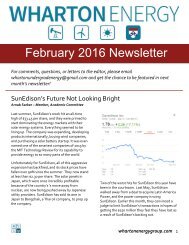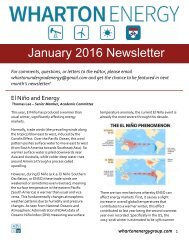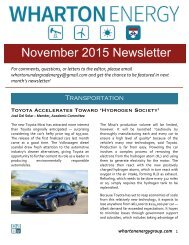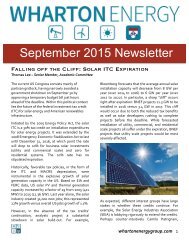Create successful ePaper yourself
Turn your PDF publications into a flip-book with our unique Google optimized e-Paper software.
selling them on the world market below cost,<br />
undercutting domestic panel-makers and<br />
uncompetitive manufacturers out of business.<br />
Over the past seven years, the costs of PV<br />
systems have fallen 80%.<br />
While most developed countries have been<br />
scaling back government incentives for solar<br />
panels, China has been increasing tariffs and<br />
subsidies offered to private industry. Both<br />
ground mounted and rooftop panels are<br />
eligible for a feed-in tariff. Feed-in tariffs allow<br />
energy producers to charge a higher price for<br />
their electricity than the retail rate, amounting<br />
to, in this situation, a subsidy of between 14<br />
and 16 cents per kilowatt hour. New public<br />
buildings and public infrastructure are also<br />
eligible for subsidies, encouraging orders for<br />
solar equipment.<br />
Looking forward, China has set its sights on<br />
reducing carbon emissions and continuously<br />
increasing their supply of solar energy. By<br />
2020, the government aims to have 15% of<br />
China’s power mix coming from renewable<br />
energy sources, and with solar panel costs so<br />
low, a large portion of this mix will be solardriven.<br />
In addition, China is seeking solar<br />
markets overseas because its current<br />
manufacturing capacity exceeds domestic<br />
demand. However, certain countries (such as<br />
the United States) are pushing back, imposing<br />
anti-dumping and anti-subsidiary tariffs on<br />
China. The two questions we are left with are<br />
how China will handle the overcapacity of solar<br />
panels that they are manufacturing, and<br />
whether the solar industry will be able to<br />
sustain itself in the long run when government<br />
subsidies are removed.<br />
Sources:<br />
World Resources Institute<br />
United Nations Environmental Programme<br />
OilPrice<br />
New York Times<br />
Apple Runs on Renewables<br />
Arthur Chen – senior member, Academic Committee<br />
There has been some big news surrounding<br />
Apple, Inc. in the past month. First, it became<br />
the first company in America to hit a $700B<br />
market capitalization. Second, there are rumors<br />
swirling around when Tim Cook will deliver the<br />
iWatch. Third, and most recently, the<br />
Cupertino-based company appears to be<br />
making a move in the electric car space.<br />
Possibly lost amongst this deluge of news was<br />
another major news story. Apple announced<br />
that it had entered into a $850 million dollar<br />
agreement to buy solar energy from First Solar,<br />
the biggest developer of solar farms in the US.<br />
The 130 megawatts of power provided by this<br />
procurement deal will be enough to power all<br />
of Apple’s headquarters, offices, stores, and<br />
data centers in California.<br />
The contract is set start almost immediately in<br />
mid-<strong>2015</strong>, and the plants (formally located in<br />
the California Flats Solar Project in Monterey<br />
County) will have an ultimate footprint of 2,900<br />
acres when it is completed by the end of 2016,<br />
1,300 of which will be allotted to Apple. This<br />
agreement builds on top of Apple’s existing<br />
investments in two 20 MW plants in North<br />
Carolina and one 20 MW plant in Nevada. At<br />
this point, all of Apple’s data centers are<br />
powered by renewables, positioning the<br />
world’s biggest company as a leader in the<br />
corporate community over the future of<br />
energy.









